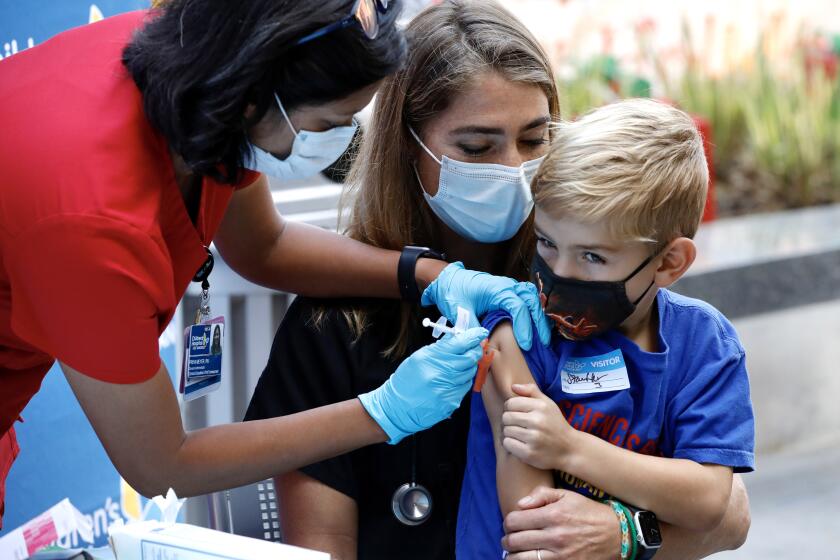At a Northern California clinic, 14 children get double the correct dose of the COVID-19 vaccine

- Share via
On Saturday, Denise Iserloth took her two sons, ages 8 and 11, to get vaccinated against COVID-19.
A few hours later, the older boy lost his balance and fell twice. Both boys complained of stomachaches and nausea.
Soon, Iserloth found out why.
The clinic, Sutter Health in Antioch, had given her sons twice the dose of the Pfizer-BioNTech vaccine that children their age should receive.
Twelve other children also received the double dose.
Medical professionals have assured Iserloth that the short-term effects should wear off in a few days and that the long-term risks are likely to be minimal.
But that’s little comfort to the mother who already had deep reservations about getting her children vaccinated.
“I was frantic when I got the call that this happened,” Iserloth said. “I’ve been crying every day. I can’t eat and I can’t sleep.”
California began to vaccinate children ages 5 to 11 this month after the Centers for Disease Control and Prevention recommended the shots for that age group.
California officials launched an ambitious rollout Wednesday of COVID-19 vaccinations for kids ages 5 to 11.
Iserloth, 38, of Oakley, was worried about side effects and a family history of allergic reactions but wanted to ensure that her sons could attend school as statewide vaccine mandates for students gradually take effect.
She also wanted them to be fully vaccinated for future family trips.
“I was trying to be proactive, even though I was not ready to get them vaccinated,” Iserloth said. “Because I know that we failed them at distance learning, and so I quietly got them vaccinated. I decided to get them both vaccinated at the same time in one trip to the clinic. Then, the clinic failed miserably.”
In a statement, Sutter Health pediatrician and COVID-19 vaccine task force chair Dr. Jimmy Hu said the 14 children “received vaccines with an incorrect amount of diluent.”
Children ages 5 to 11 receive a smaller dose than older age groups, so a diluting substance is added to the shots they receive as part of a two-dose regimen.
Instead of 10 micrograms of messenger RNA, the 14 children received about 20 micrograms, according to Sutter Health.
“As soon as we learned of this, we contacted the parents and advised them of CDC guidance in this situation,” Hu said in the statement. “The safety of our patients is our top priority, and we immediately reviewed our processes to help make sure this doesn’t happen again.”
Public health officials have said that the vaccine is safe for children and that getting them inoculated would help speed up herd immunity.
Dr. Edward Jones-Lopez, an infectious-disease specialist with Keck Medicine of USC, said the mistake at Sutter Health was not ideal but also not of grave concern.
However, it could give some a false sense that vaccines are unsafe for children, when the risks of not being vaccinated are much more serious, he said.
“In general, they’re very safe, and an increased dose, in this case by error, if it’s going to cause some trouble, it’s going to be from the injection of the vaccine,” he said. “Like any vaccine we give in childhood, they can cause fever, flu and other side effects.”
While vaccines can cause flu-like symptoms, medical researchers — including Jones-Lopez — agree they do not cause the flu.
Iserloth said that Sutter Health has not elaborated on how the mistake was made or what her family can expect next.
“Every answer that every pediatrician has told me is they expect my children to be fine, but there is no guarantee,” said Iserloth. “I have this immense mom guilt.”
By Tuesday evening, her children were feeling a little better, though she had to pick up her 11-year-old early from school after he felt nauseated.
She is certain of one thing: Her children will not be getting second doses of the vaccine until her questions are answered, she said.
More to Read
Sign up for Essential California
The most important California stories and recommendations in your inbox every morning.
You may occasionally receive promotional content from the Los Angeles Times.
















